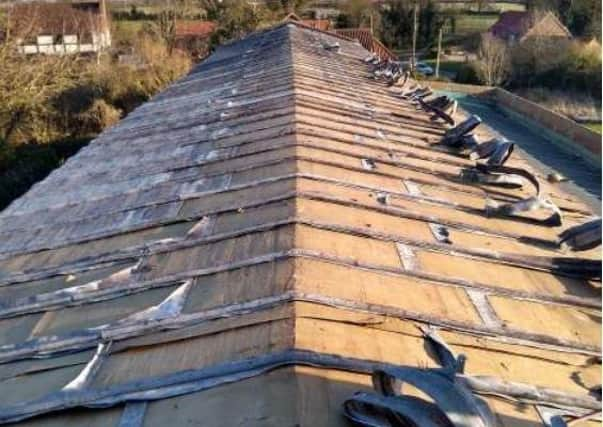Lincolnshire Police and Historic England talk of impact to church communities and history caused by gang of jailed lead thieves


The four defendants stripped tonnes of lead from a mixture of Grade 1 and Grade 2 churches between May 2018 and March 2020 - costing 36 churches a combined total of almost £2.1m. The amount the defendants would have made from scrapping the lead is estimated to have been far lower than the cost to the churches.
All four men have previously pleaded guilty to a total of 36 offences and yesterday (Wednesday) were sentenced at Lincoln Crown Court.
Advertisement
Advertisement
Constantin Motescu, 32, of Stebbings, Sutton Hill, Telford, admitted 23 charges of theft.
Paul Buica, 25, of George Street, Birmingham, admitted 16 thefts.
Mihai Birtu, 24, of Port Street, Evesham, admitted 14 thefts.
Laurentiu Sucea, 38, of George Street, Birmingham, admitted 13 thefts.
Advertisement
Advertisement
Motescu and Sucea were each jailed for six and a half years. Buica was jailed for six years. Birtu was jailed for three years and seven months.
The crime wave prompted a joint investigation between Lincolnshire Police, Cambridgeshire Police, Avon and Somerset Constabulary and Humberside Police named “Operation History”.
Detective Chief Inspector Jon Shield, leading the investigation, said: “Working in partnership with other forces and agencies including the Diocese of Lincoln and Historic England, our dedicated Operation History team have worked tirelessly to ensure justice is served.
“Some of the church congregations are still struggling to find the funds to repair the damage and restore their significant historical buildings which means so much to them as well as the local communities they serve.”
Advertisement
Advertisement
He added: “The vast majority of these churches will have had insurance in place, but the insurance only covers a small part of the costs so congregations have been left to foot the remainder of the bill.
“The impact of these offences goes well beyond the significant financial cost. Communities have felt a great sense of loss at the damage caused to their heritage, and increased vulnerability due to the rural nature of many of the premises.
“It is still unclear what these defendants spent the money they gained from these thefts on and investigations into this are still ongoing.
“Some of the buildings are thousands of years old so these men have potentially destroyed hundreds of years of our heritage.”
Advertisement
Advertisement
The counties hardest hit by the crime spree were Lincolnshire, Somerset, Cambridgeshire and Yorkshire.
Thefts also occurred from churches in Wiltshire, Suffolk, Leicestershire and Derbyshire.
Michael Cranmer-Brown, prosecuting, said “The defendants travelled the length and breadth of the country to churches set in small rural locations arriving there in the early hours of the morning, climbing on to the roof and removing large amounts of lead under cover of darkness.
“Lincolnshire as a county was particularly hard hit.”
Lead valued at £50,000 was stolen from St Andrew’s Church in Billingborough during December 2019. Among those other churches which fell victim in Lincolnshire were St Nicholas in Normanton, near Caythorpe, St Mary and St Nicholas at Wrangle, St Swithin’s at Baumber and St Bartholomew at Covenham St Bartholomew.
Advertisement
Advertisement
The damage to St Bartholomews at Covenham was valued at £250,000 and the other targeted churches all suffered significant damage with the loss of the lead causing water ingress which damaged the inside of the buildings.
The prosecutor said that loss of lead damaged not only the church buildings but caused serious problems to the local communities.
During 2019 Lincolnshire Police set up a dedicated team to work with the Diocese of Lincoln after the spike in lead theft cases.
Chief inspector Phil Vickers said: “During 2019 Lincolnshire Police worked with the Lincoln Diocese and individual church premises across the county, providing site-specific advice to 53 premises as well as broader guidance to prevent offending, in addition to several hundred site visits that had been carried out previously.
Advertisement
Advertisement
“The impact of these offences goes well beyond the significant financial cost. Communities have felt a great sense of loss at the damage caused to their heritage, and increased vulnerability due to the rural nature of many of the premises.
“We know that in addition to the loss of lead, extensive damage has been caused to the fabric of the buildings by water ingress during bad weather.
“We continue to work with rural communities to prevent offending, and encourage anyone seeing or hearing anything suspicious at Heritage Sites, particularly at night but also during the day, to contact Police immediately.”
Duncan Wilson, Chief Executive of Historic England said: “The outcome of this case highlights the benefits of collaborative working between the Police, Crown Prosecution Service, church communities and Historic England and is an approach we shall continue to use when dealing with metal theft.
Advertisement
Advertisement
“The theft of metal from historic church buildings is a serious and organised crime.
“Removing large areas of lead or copper from roofs has not just a serious financial effect on church communities but a huge effect on their morale.”
Mark Harrison, Head of Heritage Crime Strategy for Historic England said: “The metal stolen will have historic and cultural value and its removal leads to irreparable damage to protected heritage buildings, which is why tackling this problem is so important.”
Related: